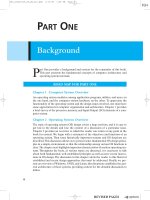Operating system internal and design principles by williams stallings chapter 08
Bạn đang xem bản rút gọn của tài liệu. Xem và tải ngay bản đầy đủ của tài liệu tại đây (526.91 KB, 72 trang )
Virtual Memory
Chapter 8
1
Hardware and Control
Structures
• Memory references are dynamically translated
into physical addresses at run time
– A process may be swapped in and out of main
memory such that it occupies different regions
• A process may be broken up into pieces that
do not need to located contiguously in main
memory
• All pieces of a process do not need to be
loaded in main memory during execution
2
Execution of a Program
• Operating system brings into main memory a
few pieces of the program
• Resident set - portion of process that is in main
memory
• An interrupt is generated when an address is
needed that is not in main memory
• Operating system places the process in a
blocking state
3
Execution of a Program
• Piece of process that contains the logical
address is brought into main memory
– Operating system issues a disk I/O Read
request
– Another process is dispatched to run while
the disk I/O takes place
– An interrupt is issued when disk I/O
complete which causes the operating system
to place the affected process in the Ready
state
4
Advantages of
Breaking up a Process
• More processes may be maintained in main
memory
– Only load in some of the pieces of each
process
– With so many processes in main memory, it
is very likely a process will be in the Ready
state at any particular time
• A process may be larger than all of main
memory
5
Types of Memory
• Real memory
– Main memory
• Virtual memory
– Memory on disk
– Allows for effective multiprogramming and
relieves the user of tight constraints of main
memory
6
Thrashing
• Swapping out a piece of a process just before
that piece is needed
• The processor spends most of its time
swapping pieces rather than executing user
instructions
7
Principle of Locality
• Program and data references within a process
tend to cluster
• Only a few pieces of a process will be needed
over a short period of time
• Possible to make intelligent guesses about
which pieces will be needed in the future
• This suggests that virtual memory may work
efficiently
8
Support Needed for
Virtual Memory
• Hardware must support paging and
segmentation
• Operating system must be able to management
the movement of pages and/or segments
between secondary memory and main memory
9
Paging
• Each process has its own page table
• Each page table entry contains the frame
number of the corresponding page in main
memory
• A bit is needed to indicate whether the page is
in main memory or not
10
Paging
11
Modify Bit in
Page Table
• Modify bit is needed to indicate if the page has
been altered since it was last loaded into main
memory
• If no change has been made, the page does not
have to be written to the disk when it needs to
be swapped out
12
13
Two-Level Scheme for
32-bit Address
14
Page Tables
• The entire page table may take up too much
main memory
• Page tables are also stored in virtual memory
• When a process is running, part of its page
table is in main memory
15
Inverted Page Table
• Used on PowerPC, UltraSPARC, and IA-64
architecture
• Page number portion of a virtual address is
mapped into a hash value
• Hash value points to inverted page table
• Fixed proportion of real memory is required
for the tables regardless of the number of
processes
16
Inverted Page Table
•
•
•
•
Page number
Process identifier
Control bits
Chain pointer
17
18
Translation Lookaside Buffer
• Each virtual memory reference can cause two
physical memory accesses
– One to fetch the page table
– One to fetch the data
• To overcome this problem a high-speed cache
is set up for page table entries
– Called a Translation Lookaside Buffer
(TLB)
19
Translation Lookaside Buffer
• Contains page table entries that have been
most recently used
20
Translation Lookaside Buffer
• Given a virtual address, processor examines
the TLB
• If page table entry is present (TLB hit), the
frame number is retrieved and the real address
is formed
• If page table entry is not found in the TLB
(TLB miss), the page number is used to index
the process page table
21
Translation Lookaside Buffer
• First checks if page is already in main memory
– If not in main memory a page fault is issued
• The TLB is updated to include the new page
entry
22
23
24
25









